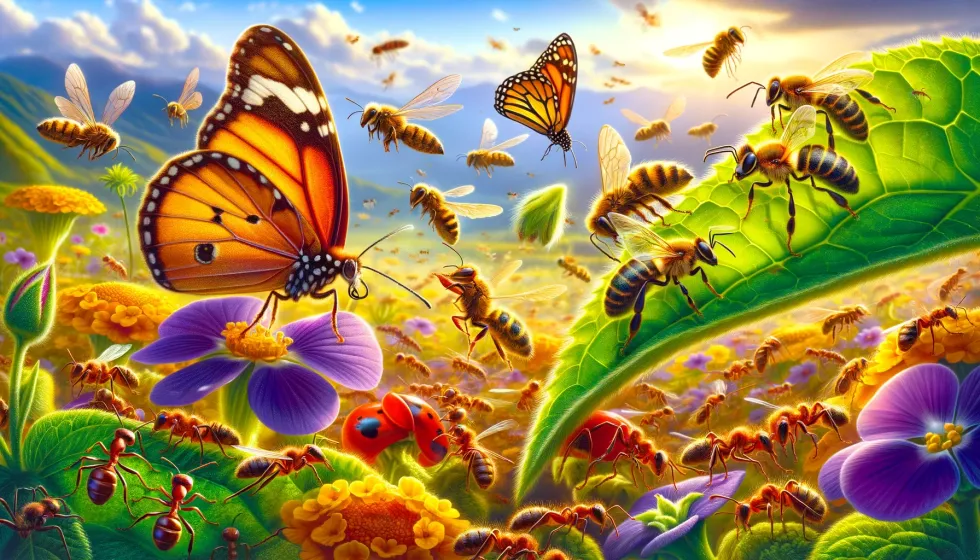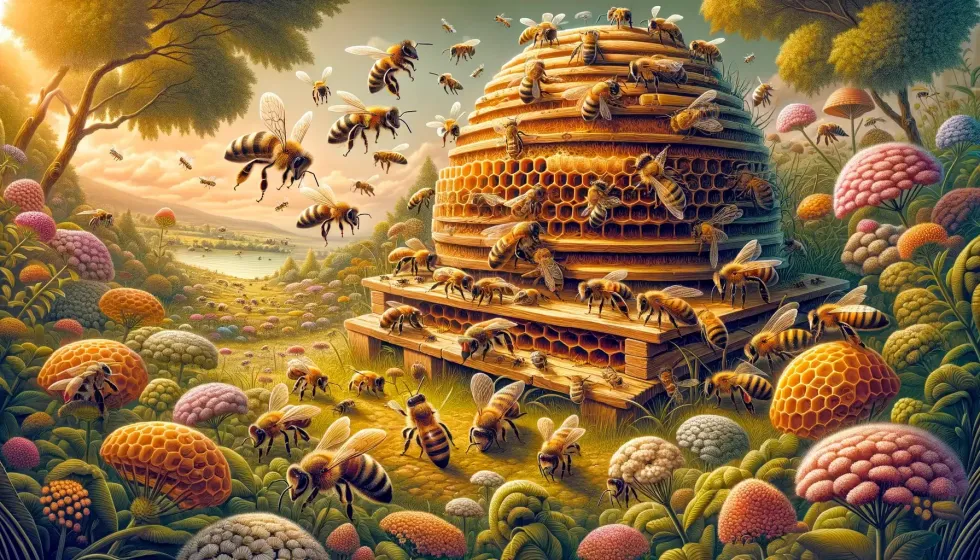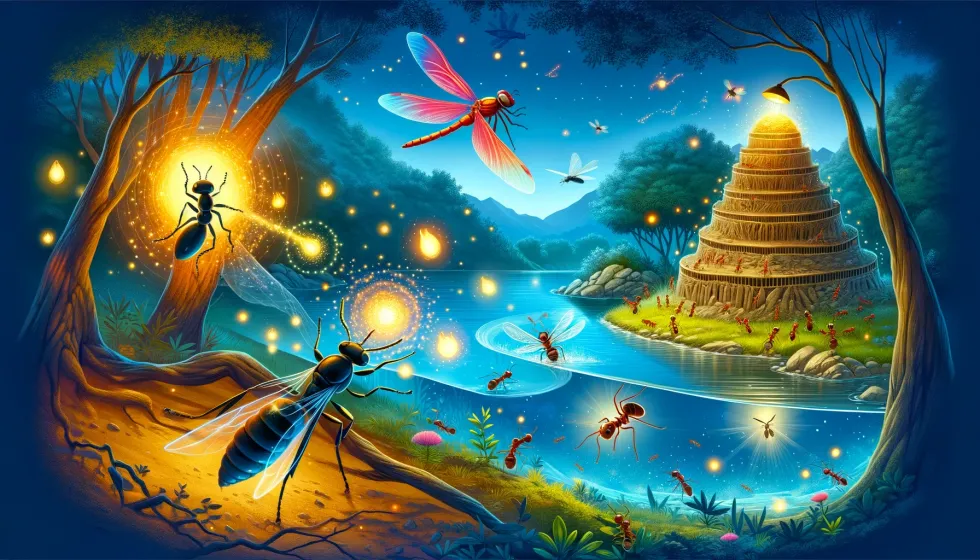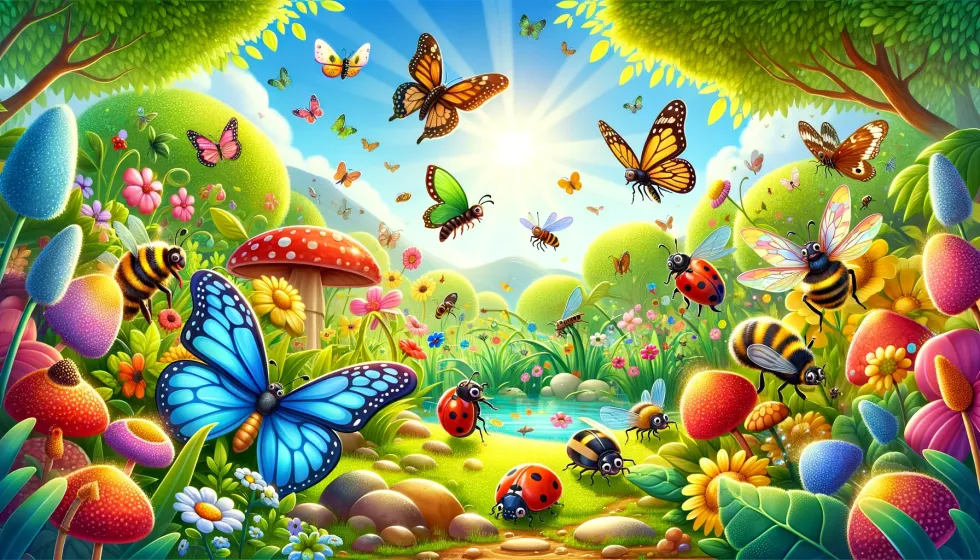Is An Insect An Animal? Insect Facts Answered For Kids!

Content
- Intriguing Insect Facts That Buzz With Wonder
- Intriguing Insect Facts That Buzz With Wonder
- Bug-sized Facts About Insects And What They Eat
- Extraordinary Insect Abilities That Will Amaze You
- What is the most common insect found worldwide?
- Can insects feel pain in the same way humans do?
- What role do insects play in the ecosystem?
- How can you tell the difference between male and female insects?
- Do all insects have wings?
- How do insects communicate with each other?
- What is the lifespan of an insect?
- How do insects breathe without lungs?
- What are the predators of insects?
- How do insects contribute to medical and scientific research?
- What insect lives the longest?
- Do all insects have six legs?
The term 'insect' might conjure images of tiny creatures that buzz, crawl, or flutter around. Though often overlooked, these magnificent beings are indeed animals and hold a huge presence on Earth, populating nearly every environment known to humans. Insects belong to the phylum Arthropoda, the largest and most diverse group of living creatures, and play essential roles in nature.
Insects, with their extraordinary variety and sheer numbers, rival the stars in the sky in terms of their roles, whether it's beetles enriching the soil or moths spreading pollen under the cloak of night. These insect facts aren't just small details, they're important parts of Earth's rich and diverse web of life.
Set on a journey to uncover astonishing insect facts, from the flight of dragonflies to the industrious lives of ants, and get ready to be amazed by these tiny yet mighty members of the animal kingdom.
Intriguing Insect Facts That Buzz With Wonder

The world of insects is teeming with secrets and surprises. Prepare to dive into a realm of fascinating creatures and uncover some amazing bug facts that highlight their unique behaviors and roles.
- A honeybee's work is nothing short of extraordinary. To produce just one pound of honey, these dedicated foragers visit about two million flowers, tirelessly collecting nectar that will later become sweet honey.
- While images of insects eating decaying meat might come to mind, most insects actually practice active hunting. About one-third of all insect species are equipped with specialized predatory skills, seeking live prey to satisfy their carnivorous appetite.
- Known for their sharp stingers, wasps also have a lesser-known trait: a taste for fermenting juice. As these insects feed on the sweet liquid, they can become inebriated, leading to an unusual sight of 'drunk' wasps occasionally passing out from the feast.
- The red postman butterfly develops its own potent defense mechanism by consuming toxic plants during its larval stage. Through this diet, it assimilates toxins into its body, warding off potential predators with a chemical shield built from its very sustenance.
- Picture a dragonfly, wings spanning up to two and a half feet, gliding above prehistoric marshes. These ancient dragonflies were some of the largest species ever to have taken flight, ruling the skies millions of years ago. But, it's not just about size, a vast array of insect species, from the monarch butterflies to fruit flies, contribute to Earth's ecological balance in essential ways.
- Insects rank as one of the most diverse groups in the animal kingdom. Scientists have described more than a million species of insects to date, with many more waiting to be discovered, making them the largest contingent of biodiversity on earth.
- From ants to bees, many groups of insects show extraordinary cooperation when it comes to gathering food. These insects work in unison to ensure the survival of their colony, exhibiting complex social structures and communication methods.
- Did you know that houseflies can detect sugar with their feet? They have chemoreceptors on their legs that are highly sensitive to sugars, allowing them to taste potential food sources by walking on them. This taste system is more sensitive to certain substances, such as sugars, than the human taste system, which relies on taste buds primarily located on the tongue.
- Grasshoppers possess unique organs in their hind legs that store energy, allowing them to leap huge distances. This stored energy acts like a spring, launching them into the air and enabling their impressive jumps.
Intriguing Insect Facts That Buzz With Wonder

The world of insects is teeming with secrets and surprises. Prepare to dive into a realm of fascinating creatures and uncover some amazing bug facts that highlight their unique behaviors and roles in our ecosystem.
- A honeybee's work is nothing short of extraordinary. To produce just one pound of honey, these dedicated foragers visit about two million flowers, tirelessly collecting nectar that will later become sweet honey.
- While images of insects eating decaying meat might come to mind, most insects actually practice active hunting. About one-third of all insect species are equipped with specialized predatory skills, seeking live prey to satisfy their carnivorous appetite.
- Known for their sharp stingers, wasps also have a lesser-known trait: a taste for fermenting juice. As these insects feed on the sweet liquid, they can become inebriated, leading to an unusual sight of 'drunk' wasps occasionally passing out from the feast.
- The red postman butterfly develops its own potent defense mechanism by consuming toxic plants during its larval stage. Through this diet, it assimilates toxins into its body, warding off potential predators with a chemical shield built from its very sustenance.
- Picture a dragonfly, wings spanning up to two and a half feet, gliding above prehistoric marshes. These ancient dragonflies were some of the largest species ever to have taken flight, ruling the skies millions of years ago. But, it's not just about size, a vast array of insect species, from the monarch butterflies to fruit flies, contribute to Earth's ecological balance in essential ways.
- Insects rank as one of the most diverse groups in the animal kingdom. Scientists have described more than a million species of insects to date, with many more waiting to be discovered, making them the largest contingent of biodiversity on earth.
- From ants to bees, many groups of insects show extraordinary cooperation when it comes to gathering food. These insects work in unison to ensure the survival of their colony, exhibiting complex social structures and communication methods.
- Did you know that houseflies can detect sugar with their feet? They have chemoreceptors on their legs that are highly sensitive to sugars, allowing them to taste potential food sources by walking on them. This taste system is more sensitive to certain substances, such as sugars, than the human taste system, which relies on taste buds primarily located on the tongue.
- Grasshoppers possess unique organs in their hind legs that store energy, allowing them to leap huge distances. This stored energy acts like a spring, launching them into the air and enabling their impressive jumps.
Bug-sized Facts About Insects And What They Eat

The gamut of insect diets is as diverse as the plethora of species themselves, ranging from the delectable to the downright detestable. These minute creatures sustain themselves on everything from the sweet nectar of spring's first bloom to the decomposing remnants of forest floors.
Such varied diets underscore the adaptability of insects to virtually all of Earth's habitats, and these feeding habits play a pivotal role in the intricate web of life, affecting pollination, decomposition, and the larger food chain.
- Monarch butterflies are known for eating toxic plants as caterpillars, a clever trick that stores energy and keeps predators at bay with their own poison.
- Many insects are detritivores, organisms that feed on dead and decomposing organic matter, known as detritus. Some, like the dung beetle and certain types of flies, specialize in feeding on decaying meat, playing a crucial role in breaking down and recycling organic matter.
- Have you ever heard of a bug that enjoys smelly feet? It's true! Some flies are attracted to the odor, helping them locate food and places for laying eggs.
Extraordinary Insect Abilities That Will Amaze You

Insects' superpowers go far beyond what most living creatures, including humans, can achieve. Insect anatomy is a testament to evolution's ingenuity, with each part serving an essential purpose.
- The dung beetle, an insect powerhouse, can move objects over a thousand times heavier than itself, much like a human pulling six double-decker buses.
- Ever wondered how butterflies find their food? Unlike humans who taste with their tongues, butterflies taste with their feet, identifying the right plants to nourish their offspring.
- The hind legs of grasshoppers are not just for jumping, some species of grasshoppers existed a million years ago and are believed to have used their powerful legs during elaborate mating rituals.
- Insects like dragonflies, with their compound eyes, have unrivaled vision for spotting and capturing prey, much akin to a camera with a thousand lenses.
- Bees and wasps boast four wings, but when they fly, they lock their wings together to function as one pair, showcasing remarkable efficiency.
- Did you know that Mexican jumping beans contain a surprise? Inside each one lives a bean moth larva, whose movements can make the bean twitch and jump around.
FAQs
What is the most common insect found worldwide?
Among countless insects, the most commonly found globally is the ant. There are over 10,000 known species of ants, and their colonies can be found on almost every landmass on Earth.
In addition to ants, the planet is teeming with other ubiquitous insects. The domestic housefly is found in nearly all human-inhabited areas around the world, thriving where food and waste create favorable conditions for their life cycle.
Mosquitoes are also widespread, particularly in warmer climates and near bodies of stagnant water where they can lay their eggs.
The versatile cockroach is another insect that has adapted to a variety of environments, from tropical regions to urban dwellings.
Beetles, the largest order of insects with over 350,000 known species, are found in nearly every habitat except for the sea and the polar regions. These common insects, along with ants, represent a significant portion of the global insect population, occupying diverse roles that influence ecosystems on a vast scale.
Can insects feel pain in the same way humans do?
The question of whether insects feel pain is a topic of debate among entomologists. Current research suggests that insects don't experience pain the same way humans do, as their nervous systems are significantly simpler. However, they do react to harmful stimuli, which might be a basic response rather than an experience of pain.
What role do insects play in the ecosystem?
Insects play several critical roles in ecosystems, including pollination, decomposition, soil aeration, and as a food source for other animals. They are integral to the survival of many plants and animals, as well as being crucial for agricultural and ecological balance.
Building on their pivotal ecological roles, specific insects have become synonymous with particular ecosystem functions. Bees, for example, are renowned pollinators that facilitate the reproduction of flowering plants, which results in fruits, vegetables, and seeds that provide food for a myriad of organisms.
Dung beetles, on the other hand, play an essential role in decomposition, recycling nutrients back into the soil and reducing the spread of disease by burying and feeding on feces.
Earthworms, often considered nature's plowmen, are paramount in soil aeration as they tunnel through the earth, enhancing soil structure and nutrient cycling.
Similarly, ladybugs are natural pest controllers, consuming aphids and thus aiding in plant health and productivity. Such varieties of insects each contribute to the balance and health of their habitats, showcasing the intricate and indispensable relationships that drive ecosystem dynamics.
How can you tell the difference between male and female insects?
Male and female insects can often be distinguished by size, morphology, and behavior. In many species, males are smaller and may have more ornate features, such as brightly colored bodies or larger antennae, while females often have structures for laying eggs.
Do all insects have wings?
Not all insects have wings. While many species have wings and the capability to fly, certain insects like lice, fleas, and some ants have lost their wings over evolutionary time. Wingless insects have often developed other means of mobility, such as jumping or running.
How do insects communicate with each other?
Insects communicate using a wide range of methods, including chemical signals (pheromones), sounds, visual cues, and vibrations. Some species, like bees, even use complex behaviors like the waggle dance to relay information about food sources to their hive mates.
What is the lifespan of an insect?
The lifespan of insects can greatly vary depending on the species. Some insects like mayflies live for only 24 hours, while others like termite queens can live for decades. Most insects fall somewhere in between, with life spans ranging from days to years.
How do insects breathe without lungs?
Insects breathe through a network of tiny tubes called tracheae. Air moves in and out of these tubes through a series of openings called spiracles located along the sides of their bodies. This system allows for the diffusion of oxygen directly to their tissues.
What are the predators of insects?
Insects have a wide range of predators, including birds, reptiles, mammals, other insects (like praying mantises and ladybugs), and even plants like the Venus flytrap. Their predators vary depending on the insect's environment and life stage.
How do insects contribute to medical and scientific research?
Insects play a significant role in medical and scientific research due to their complex behaviors, simple genetics, and physiological similarities to humans. Fruit flies, for example, are used in genetic research because they share 75% of the genes that cause diseases in humans.
Alongside fruit flies, other insects like honeybees and mosquitoes have been iconic in medical studies. Honeybees have offered insights into the development of antibiotics through the study of their honey, propolis, and venom, which possess antimicrobial properties.
Mosquitoes, being carriers of diseases like malaria and dengue, are closely studied to understand disease transmission and develop preventive measures.
Additionally, the humble silk moth has contributed to biomaterial research, providing silk proteins used in tissue engineering and regenerative medicine.
What insect lives the longest?
Of the known insect facts, termites, particularly queens, can live the longest, with lifespans of up to 50 years under optimal conditions. This is remarkably longer than most other insects, whose lifespans are typically much shorter.
In addition to termite queens, several other insects are known for having surprisingly long lifespans. For instance, queen ants can live for up to 30 years, which is an impressive feat compared to the brief existence of many insect species.
Cicadas, particularly those of the genus Magicicada, spend the majority of their lives as nymphs underground for 13 or even 17 years before emerging as adults for a six-week period above ground.
Certain beetles also exhibit longevity, with some species like the stag beetle living for several years in the larval stage before maturing into adulthood.
Do all insects have six legs?
As a defining characteristic, all adult insects have six legs. This feature is part of the basic body plan of insects and helps to distinguish them from other arthropods, like spiders, which have eight legs.
Insects might be small, but they are one of the most diverse groups of animals on Earth. With millions of species, each with unique traits and behaviors, they are vital to ecosystems worldwide.
From the butterflies that flutter by to the beetles that burrow in the ground, insects connect with nearly all aspects of life.
They pollinate plants, break down waste, and serve as a crucial food source for other species. These fun facts about bugs give just a glimpse into their wondrous world, a world that continues to intrigue and inspire scientists and nature lovers alike.
- Fun Leaf-footed Bug Facts For Kids ›
- Fun Lychee Stink Bug Facts For Kids ›
- Fun Harlequin Bug Facts For Kids ›
- Fun Giant Water Bug Facts For Kids ›
- Fun Large Milkweed Bug Facts For Kids ›
We Want Your Photos!
More for You
Sources
https://www.natgeokids.com/uk/discover/animals/insects/15-facts-about-bugs/
https://safepropest.com/cool-insect-facts/
https://www.britannica.com/animal/arthropod
https://www.bbka.org.uk/the-other-things-honeybees-make
https://metro.co.uk/2018/08/08/wasps-super-angry-getting-drunk-rotten-fruit-7815081/
https://insectic.com/postman-butterfly/
https://www.spidexx.com/post/crazy-bug-facts-part-1
https://www.amnh.org/explore/ology/earth/ask-a-scientist-about-our-environment/which-animal-group-has-the-most-organisms
https://en.wikipedia.org/wiki/Eusociality
https://www.si.edu/spotlight/buginfo/bugnos
https://www.nms.ac.uk/explore-our-collections/stories/natural-sciences/monarch-butterfly/
https://mrcsl.org/dung-beetle-diet/
Bachelor of Science specializing in Computer Science

Christian MbaBachelor of Science specializing in Computer Science
Christian Mba is an experienced blogger and content writer with over a decade of experience. He holds a Bachelor of Science degree in Computer Science from Nigeria and has a keen interest in Python programming. Along with his writing and blogging expertise, he is also an SEO specialist with more than six years of experience. Chris, as he is commonly known, has a passion for music and enjoys playing the piano.
Disclaimer
1) Kidadl is independent and to make our service free to you the reader we are supported by advertising. We hope you love our recommendations for products and services! What we suggest is selected independently by the Kidadl team. If you purchase using the Buy Now button we may earn a small commission. This does not influence our choices. Prices are correct and items are available at the time the article was published but we cannot guarantee that on the time of reading. Please note that Kidadl is a participant in the Amazon Services LLC Associates Program, an affiliate advertising program designed to provide a means for sites to earn advertising fees by advertising and linking to Amazon. We also link to other websites, but are not responsible for their content.
2) At Kidadl, we strive to recommend the very best activities and events. We will always aim to give you accurate information at the date of publication - however, information does change, so it’s important you do your own research, double-check and make the decision that is right for your family. We recognise that not all activities and ideas are appropriate for all children and families or in all circumstances. Our recommended activities are based on age but these are a guide. We recommend that these ideas are used as inspiration, that ideas are undertaken with appropriate adult supervision, and that each adult uses their own discretion and knowledge of their children to consider the safety and suitability. Kidadl cannot accept liability for the execution of these ideas, and parental supervision is advised at all times, as safety is paramount. Anyone using the information provided by Kidadl does so at their own risk and we can not accept liability if things go wrong.
3) Because we are an educational resource, we have quotes and facts about a range of historical and modern figures. We do not endorse the actions of or rhetoric of all the people included in these collections, but we think they are important for growing minds to learn about under the guidance of parents or guardians.







